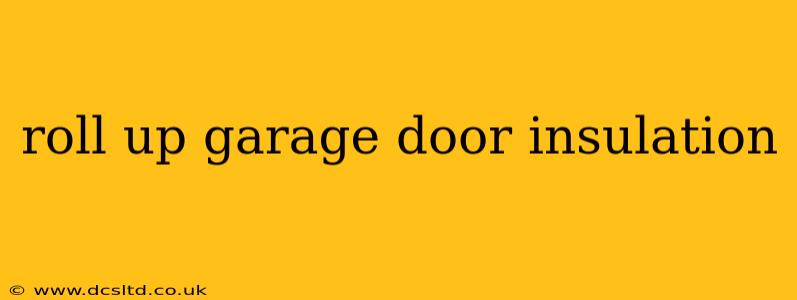Keeping your garage comfortable year-round can significantly impact your home's energy efficiency and overall comfort. A significant source of heat loss (in winter) and heat gain (in summer) often comes from the garage door itself. This comprehensive guide delves into the various methods of roll-up garage door insulation, helping you choose the best solution for your needs and budget.
Why Insulate Your Roll Up Garage Door?
Before we explore insulation methods, let's understand the benefits. Insulating your roll-up garage door offers several advantages:
- Energy Savings: A well-insulated garage door prevents heat from escaping during winter and reduces heat absorption during summer, directly impacting your energy bills. This is especially important if your garage is attached to your home.
- Improved Comfort: A warmer garage in winter and cooler garage in summer translates to a more comfortable living space, particularly if your garage is connected to your house.
- Protection for Stored Items: Insulation protects stored items from extreme temperatures, preventing damage to sensitive equipment, tools, or vehicles.
- Reduced Noise: Some insulation methods can help dampen external noise, creating a quieter garage environment.
What are the Different Types of Roll Up Garage Door Insulation?
Several methods exist for insulating a roll-up garage door, each with pros and cons:
1. Insulated Garage Door Panels:
This is the most effective method, involving replacing your existing door with a new one featuring built-in insulation. These doors usually have a polyurethane or polystyrene core sandwiched between layers of steel or wood.
Pros: Superior insulation value, long-lasting, improves the overall appearance of the garage. Cons: Most expensive option, requires professional installation.
2. Insulated Garage Door Inserts/Kits:
These kits are designed to fit inside the existing garage door panels, adding a layer of insulation. They often come in various materials like rigid foam board, and are usually easier to install than a full door replacement.
Pros: More affordable than replacing the entire door, relatively easy DIY installation. Cons: Insulation value may be less than fully insulated doors, can be bulky, and may affect the door's operation.
3. Garage Door Insulation Blankets:
These are flexible blankets or rolls of insulation material that are attached to the inside of the garage door panels. They are generally inexpensive and easy to install, but their effectiveness is less than more rigid insulation methods.
Pros: Budget-friendly, easy DIY installation. Cons: Can be less effective than other methods, may not provide a perfect seal, less aesthetically pleasing.
4. Reflective Insulation:
This type of insulation uses a reflective material, such as aluminum foil, to reflect heat away from the garage door. It is often used in conjunction with other insulation methods to enhance their effectiveness.
Pros: Inexpensive, easy to install, reflective properties improve both summer and winter performance. Cons: Often less effective as a standalone insulation solution.
How Much Does Roll Up Garage Door Insulation Cost?
The cost of insulating your roll-up garage door varies greatly depending on the chosen method. Replacing the entire door is the most expensive option, ranging from several hundred to thousands of dollars, while insulation kits and blankets are much more affordable. Expect to pay anywhere from a few hundred dollars to over two thousand, depending on your chosen method and the size of your garage door.
What R-Value Should I Look For in Garage Door Insulation?
The R-value indicates the insulation's effectiveness. Higher R-values mean better insulation. Aim for an R-value of at least R-10 or higher for optimal performance. However, the best R-value will depend on your climate and individual needs.
How to Choose the Right Insulation for Your Garage Door?
Consider these factors when selecting your insulation method:
- Budget: Determine how much you're willing to spend.
- DIY Skills: Assess your comfort level with installation.
- Climate: A colder climate may require a higher R-value.
- Aesthetic Preferences: Consider how the insulation will look from inside the garage.
By carefully considering these factors, you can choose the most effective and cost-efficient insulation solution for your garage door.
This detailed guide provides a comprehensive overview of insulating your roll-up garage door. Remember to always consult local professionals for advice tailored to your specific situation.
